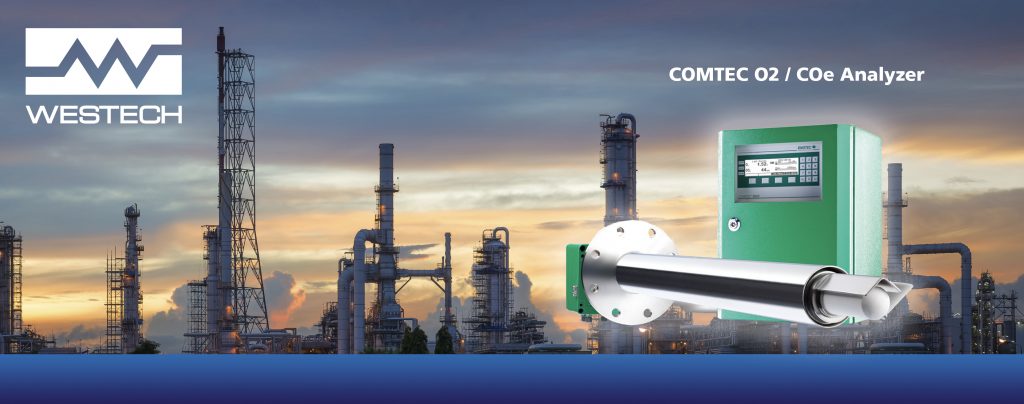Refineries contain a wide range of processes and manufacturing steps which produce products from crude oil. What these steps all have in common is a high demand for heat or steam which is derived from a combustion process.

Controlling the air-fuel-ratio of a combustion process usually takes place through monitoring of excess O2 in the flue gas after the boiler or furnace.
The O2 measurement is linked to an air damper or actuator which feeds air to the furnace according to a required load.
To increase combustion efficiency (reduce fuel usage and emissions output) as well as increase the safety of the combustion, ENOTEC, a mid-sized company based in western Germany, developed and produces the mixed potential COMTEC COe sensor which measures in situ in the flue gas of a boiler or furnace. This sensor measures alongside ENOTEC’s industry leading ZrO2 oxygen sensor, directly in the process gas in the COMTEC O2 / COe analyzer.
The additional COe measurement enables fine-tuning of a combustion process by enabling the reduction of excess O2 in the furnace to an optimal concentration. This is the point where the excess O2 concentration is low and the production of CO(e ) molecules can be monitored and kept as low as possible. Keeping the excess O2 concentration low has a financial benefit because in process combustions, higher O2 concentrations are wasteful due to unnecessary heat loss.
On the other hand, reducing excess O2 to a point where there is a deficiency of combustion air (Lambda < 1) will result in unburned fuel in the flue due to incomplete combustion.
The wet COe value (all combustibles – CO, H2 Cy Hy) in addition to O2 after combustion is hugely important, more so in refineries as the fuel may contain H2 which cannot be measured by a classical extractive CO analyzer. Additionally, because the COe and O2 sensors react stoichiometrically inversely to each other (low O2 measurement = high COe measurement and vice versa), each measurement is constantly checked for plausibility.
Should for instance the O2 measurement drop but the COe measurement stays at previous concentrations, this would be implausible from a combustion point of view and the cause must be found elsewhere (e.g. a boiler tube has burst and the increased moisture in the flue gas displaces O2, lowering the O2 concentration in the process gas).
Measuring in situ directly in the wet flue gas has many advantages and very few drawbacks:
- Firstly, the measurement is fast.This is immensely important for efficient combustion control as changes in the flue gas composition are responded to immediately. Especially in hazardous areas (ATEX Zone 1 / 2) the reaction time of the measurement is critical. In an extractive analyzer system, the length of (heated) gas lines cause a delay in the measurement which may be exacerbated by a low sample gas flow rate.
- Equally important in refineries is measuring combustible gas components (COe ) in addition to O2 as this can prevent the formation of higher concentrations of unburned molecules after combustion in case of a faulty O2 sensor which can lead to safety issues:Should an O2 sensor start leaking for instance due to aging, leak air (ambient air or instrument air) will be measured in addition to the excess O2 after combustion. Aging typically takes place in sensors which where the ZrO2 sensor is glued in using a high temperature ceramic glue.
This glue is prone to cracking due to thermal stress as it cannot expand or contract with the sensor holder (stainless steel) as the sensor is heated /switched off. This sensor construction is generally considered to be inferior to soldered O2 sensors such as which are produced by ENOTEC.
Additional leak or false air results in a higher O2 concentration measured by the analyzer which will be countered by the DCS by (incorrectly) reducing combustion air to the furnace. This potentially results in the creation of a reducing atmosphere which will have destructive effects on the plant infrastructure.
The COe sensor measurement can prevent this scenario; the rising O2 measurement should result in a decrease of COe molecules. If this is not the case, false air measurement may be the cause (due to a possible leaking O2 sensor or ingress of leak air from an installation which is not gas-tight).
- When measuring in situ with the sensors directly in the hot flue gas, the sensors aren’t subjected to temperatures below the dew point and do not require any kind of extraction of sample gas.For this reason, dew point condensation and associated issues such as blockages of extraction lines or of internal filters cannot take place.
These issues typically bedevil extractive analyzer systems or quasi extractive analyzers (also called close coupled analyzers) and shorten their lifetimes by increasing the required maintenance.
Issues such as blockages in extractive analyzers are compounded if aggressive components such as SO2 are present in the flue gas. This can also lead to corrosion causing acids being formed. Measuring directly in situ thus translates into highly reduced maintenance requirements.
In conclusion, in situ measurement of COe in addition to O2 for combustion control not only has the benefit of being low maintenance, but precise optimization of the process is also possible. This is beneficial from cost-savings and environmental protection point of view.
LEARN MORE
For more information on Westech Industrial’s ENOTEC products please visit our website at https://bit.ly/3yD6VVo or call to speak to one of our technical support representatives at 1-800-912-9262.
Share This:




 CDN NEWS |
CDN NEWS |  US NEWS
US NEWS 


























COMMENTARY: Where the Fight Against Energy Subsidies Stands – Alex Epstein